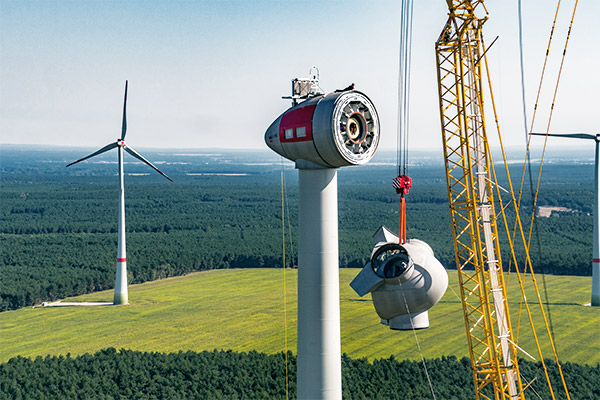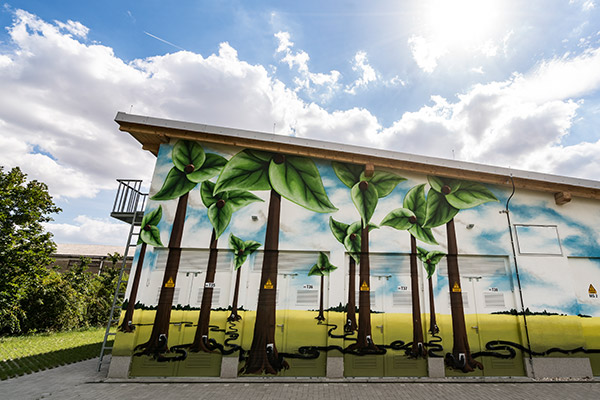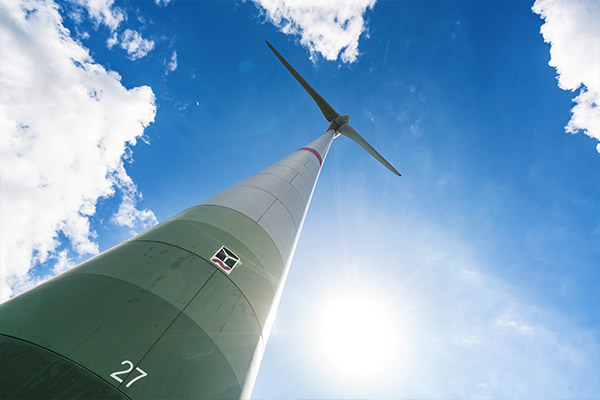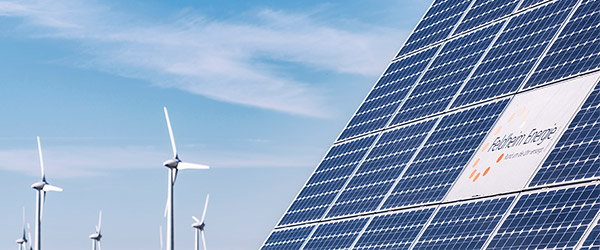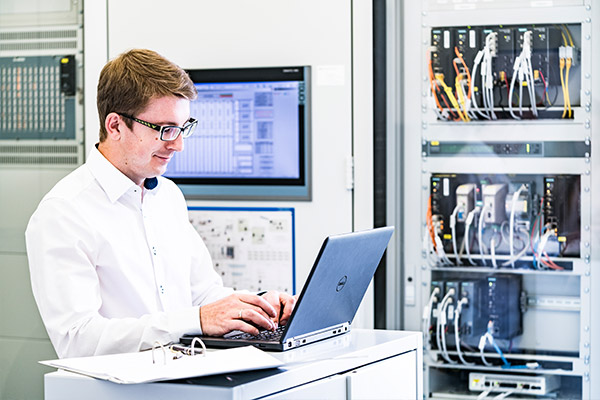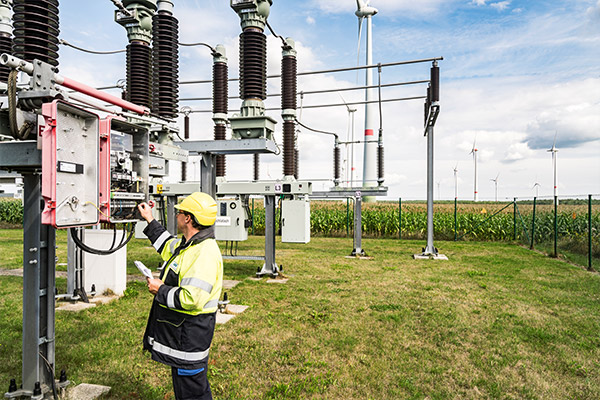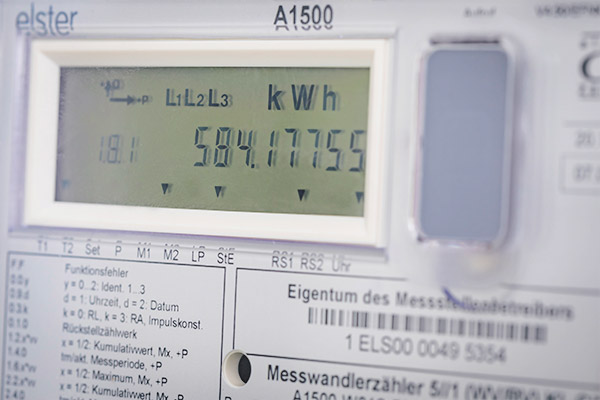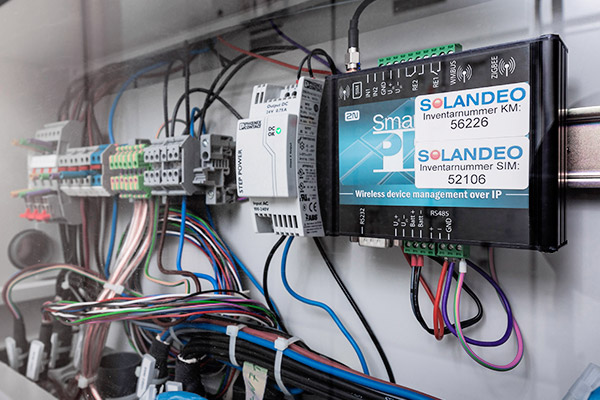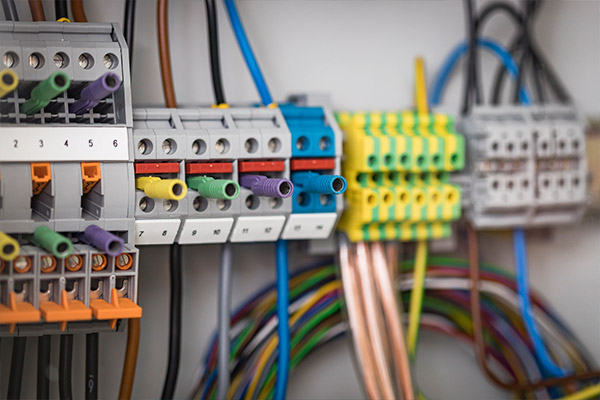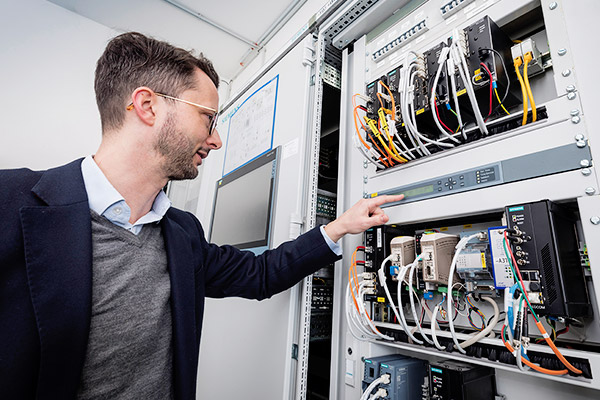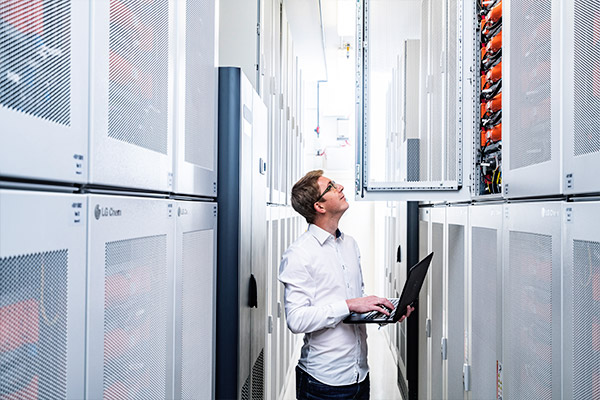Pattern detection instead of weather forecasts
Digital meters provide more and more real-time data about the generation of electricity by wind turbines and solar installations. They help to make the power grid fit for the energy transition. The Berlin start-up Solandeo uses these data for faster and cheaper forecasts with a higher geographic resolution for the generation of electricity from renewable sources. In doing so, it helps system operators and electricity traders to render the energy transition more affordable and more secure.
Feldheim is a microcosm of the energy transition
Wind drives the snow over the barren fields between the wind turbines of Feldheim, Brandenburg. A pale sun shines through the haze as Friedrich Rojahn opens a door in a brightly painted low-rise building. A blast of hot air meets us as the light reveals a narrow corridor with 48 control cabinets full of lithium-ion batteries in glaring orange. “Feldheim is a microcosm of the energy transition”, says Rojahn, co-founder of energy start-up Solandeo from Berlin. In the scope of WindNODE, Solandeo is developing new methods to better predict the generation of electricity from renewable energy sources together with Energiequelle, the operator of this large storage facility.
To this end, Solandeo has installed two of many thousands of digital meters in this low building, which houses batteries with a storage capacity of 10,700 kilowatt hours of electricity. The devices supply real-time data to the Solandeo headquarters in Berlin. Other Solandeo meters are found in wind turbines, solar installations and biogas plants throughout Germany. They tell the operators of the installations how much power their installations generate at any given time, and can be followed ‘live’ via a portal or read out in different file formats. This so-called metering point operation is Solandeo’s daily business.
Regional predictions in the range of a few hours
Within WindNODE, Solandeo is researching how to also use the data from the meters to predict the electricity production together with green power traders, wind power companies and transmission system operator 50Hertz. The objective is to further improve the use of wind turbines and solar installations and further decrease curtailments.
Contrary to the traditional approach involving weather models, Solandeo provides local predictions (down to the level of a single installation) and short-term forecasts, usually in the range of a few hours. “Our WindNODE project provides electricity traders with additional revenues on the exchange and facilitates grid management and optimisation for system operators”, says Rojahn. To analyse the millions of data from the smart meters, Solandeo uses self-learning algorithms, better known as Artificial Intelligence.
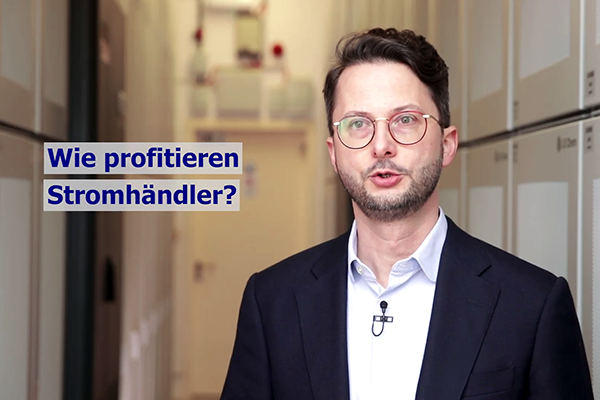
▶ Play
The YouTube video will only load and play after clicking. By clicking the video, you agree to Google's Privacy Policy.
Forecast errors cost money
The solar installations and many wind turbines in Feldheim belong to Energiequelle, a company from Kallinchen, about an hour’s driving from Feldheim. In 1997, Energiequelle was founded as a two-man company. Now, over 200 employees work for the eco-energy pioneer and together built installations with an installed capacity of at least 1,200 megawatt, which corresponds to a very large lignite-fired power plant. Weather forecasts have always been used in the field of wind power, for example to plan service and maintenance works in times when wind turbines and solar installations produce the least energy. If the forecasts predict a lot of wind, the company increases the number of employees on standby duty, as experience shows that most failures occur on wind turbines at high capacity.
The company still uses generation forecasts to this end, Doreen Raschemann explains: “A very precise forecast is important to us for the sale of green energy produced by our installations on the exchange.” Raschemann is the director of the Energiequelle foundation and head of the visitor centre in Feldheim. “Any deviation between our production forecast and the actual feed-in costs us money”, she says.
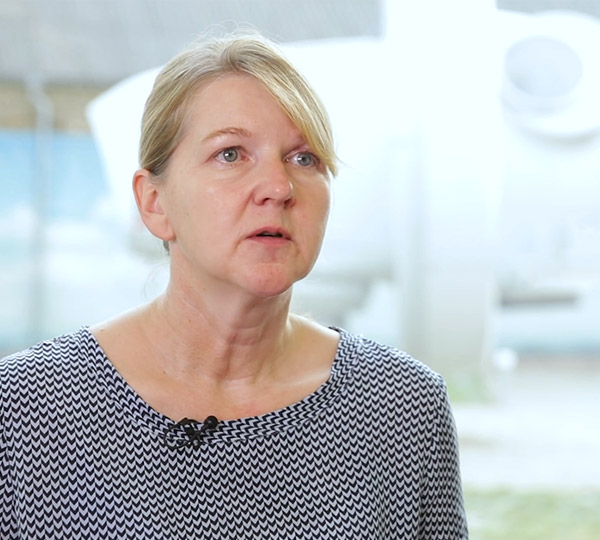
▶ Play
The YouTube video will only load and play after clicking. By clicking the video, you agree to Google's Privacy Pollicy.
Minimising uncertainties in weather forecasts
If the electricity traders offer a certain volume of electricity on the exchange, they also have to deliver it. And when the predicted electricity volume is not right, they have to buy expensive electricity or deliver surplus electricity at a cheaper price. Good electricity forecasts help minimise these losses.
“If you want to know how much electricity an installation will produce the following day or next week, one still has to keep an eye on the weather forecast in the future”, says Rojahn. After all, this works quite well, but with a certain residual uncertainty. For decades, meteorologists have been using the data from weather stations, satellites and extrapolation computers to produce better forecasts. The national German Weather Service (DWD) is one of the largest data centre operators in Germany. The forecasts become ever more elaborate: several supercomputers are running in Offenbach, which are regularly replaced for millions of euros in the double digits.
More than a dozen weather data providers access these weather forecasts for the energy industry. They in turn prepare them for customers such as Energiequelle, system operators and electricity traders. In total, the private market for such services is said to amount to 50 million euros a year in Germany alone. (Source: Deutschlandfunk Kultur). The customers often buy forecasts from up to a dozen providers and combine them as best as possible to balance out their strengths and weaknesses.
However: “Such forecasts often only provide a forecast for an area of one by one kilometre”, says Friedrich Rojahn. And because of the time-consuming calculations of the weather models, the supercomputers only issue a new forecast every few hours.
Forecasts provide grid security
For system operators, this approach often falls short, as they also have to sell the electricity from solar installations and wind turbines within their grid area through short-term trading on the exchange. Furthermore, in 50Hertz’s grid area alone (with the exception of Hamburg also the WindNODE project region), about 5,000 megawatts of solar power have been installed, which are constantly being traded on the exchanges. The trade revenues benefit all electricity customers, as they are set off against the national green power remuneration (so-called EEG surcharge).
Secondly, electricity grid operators seek to avoid that individual substations are overloaded. These substations collect the electricity from a certain area of the power grid and transform it so that it can be injected into the high and extra high voltage lines and transported from there on out. The more advance information they have about the wind and solar units in the vicinity, the more efficiently they can operate the grid and even expand it in the long term. All this saves money for system operation and reduces the cost of the energy transition.
Solandeo creates swift, small-scale forecasts
For such requirements, the predictions from the weather forecast do not suffice. This is because weather phenomena often occur in a smaller area and much more briefly. Fog, for instance, as any driver knows, can change one’s view from clear sight to complete soup over only 50 metres; the electricity generated by two neighbouring solar installations can therefore be very different. Wind turbulences are also often noticeable from one wind turbine to the next through sudden changes in output. This cannot be captured in traditional weather models.
Is there no other way?
Solandeo practically turns the traditional forecast upside down. Instead of studying satellite images, brooding over complex weather models and combining this knowledge with the output data of technical installations, Solandeo’s digital meters directly collect as many production data as possible from the highest possible number of installations, and the self-learning algorithms then look for patterns in this permanent data stream. The longer the data are analysed, the sooner conclusions can be drawn from them on how much electricity can be generated by renewable energy installations in the near future. The weatherman is replaced by algorithms that analyse large data volumes and constantly improve with the aid of ‘self-learning computer systems’ as more data is fed into them. IT specialists call this ‘big data analysis’, ‘self-learning neural networks’ and ‘artificial intelligence’. The basis for this is formed by an infrastructure of as many digital meters on renewable energy installations as possible, such as Solandeo already has a few thousand.
Recognising patterns instead of understanding the weather
The difference between traditional forecasts based on weather models: while previous methods tried to reproduce reality in the model, the big data experts of Solandeo stick to statistical correlations. The software for instance ‘sees’ that electricity meters on the wind turbines are reporting an increase in power production and that this increase is moving from south to north.
It has also learned that in case of this data pattern, it is highly likely that the next wind turbines further north will soon supply more power.
“This is not because the software has understood that the wind is picking up from the south”, says Rojahn. “The software only recognises a pattern, and that’s enough!”
Forecasts for each individual installation
Over time, the software ‘sees’ more and more statistical correlations in the incoming data: from typical generation patterns of solar installations, e.g. due to fog banks, to the curtailment of wind turbines in stormy weather conditions.
Rojahn explains the difference between the traditional forecast for weather and electricity production: “The advantage of our forecast lies in the fact that we provide new predictions every few minutes, that we do this for individual installations and that the computing power remains manageable and therefore advantageous. We supply in a very short term, with a very local focus and at a very affordable price, while also perfectly complementing the existing models”, according to the Solandeo founder.
Together with its WindNODE partners, Solandeo in the initial phase focussed on applying the big data analysis for the trade of electricity generated from renewable sources.
“We reduced the errors of the previous forecasts by up to 15 %. We can pride ourselves that this has reduced the cost for balancing energy by 25 %”, states Rojahn. The Solandeo forecast was especially valuable for traders when the weather changed quickly - such situations can hardly be predicted using the traditional method
The current, second phase focuses more on the interests of the system operators: what do the data from the digital meters tell me about the losses on the grid? Here as well, Solandeo wants to provide simple, affordable answers. By the end of 2020 at the latest, these tests should be concluded. Solandeo expects that its algorithms will offer clear cost benefits to the system operators, and as such make the energy transition more secure and more advantageous.
Solandeo: energy start-up from Berlin
Solandeo GmbH was founded in 2014 by Friedrich Rojahn (CEO), Nathanael Obermayer (CTO) and Jan Jacobs (COO) in Berlin. The three founders have professional experience in the energy industry, software development in the domain of big data analysis, and corporate development. After funding by the Berlin Climate-KIC at the EUREF Campus and the High-Tech Gründerfonds of the Federal Republic of Germany, Technische Werke Ludwigshafen (TWL) AG 2016 acquired a minority interest. In 2017, the merger with SOTA Solutions GmbH, which was active with the analysis of large data volumes and the derived prognoses as a foundation at TU Berlin.
The main business activities are the operation of digital meters as well as the processing of data for its clients. As a result of its participation in WindNODE, additional services such as generation forecasts are developed. Solandeo employs 30 employees in Berlin.
Energiequelle: renewable energy from the very start
Since 1997, Energiequelle GmbH has been active on the renewable energy market. The company plans and realises wind and solar installations as well as substations and energy storage units. Energiequelle furthermore handles the commercial and technical operations. With over 200 employees in Germany, France and Finland, Energiequelle is an international company; passionate, bold and humane.
3 questions for …
What does WindNODE have to offer?
For us, WindNODE is a large opportunity to work with a large volume of data directly from the energy industry and improve our forecast method. Only when we know which problems of the energy transition are faced by system operators, renewable energy companies and electricity traders, who all work together in WindNODE, can we develop new solutions that are also practicable. Through WindNODE, we also have an exchange with three Fraunhofer institutes, which are among the best in the world in their field. All of which helps us tremendously.
Were there any unexpected successes during the project?
In fact, our activities had a strong focus on the massive use of digital meters. However, the new smart meters, so-called intelligent metering systems, are not being introduced as soon as we hoped. These delays were a considerable challenge in the WindNODE project. Nevertheless, we and our partners succeeded in generating useful data and analyse these using our software techniques. This way, we learned to also use data from other domains. As a next step, we can continue to improve ourselves significantly by using data from smart meters.
Where can you see this in action?
For now, you can only find our smart meters in wind farms or biogas plants. That is why we are presenting the project on www.erneuerbare-energie-prognosen.de.


